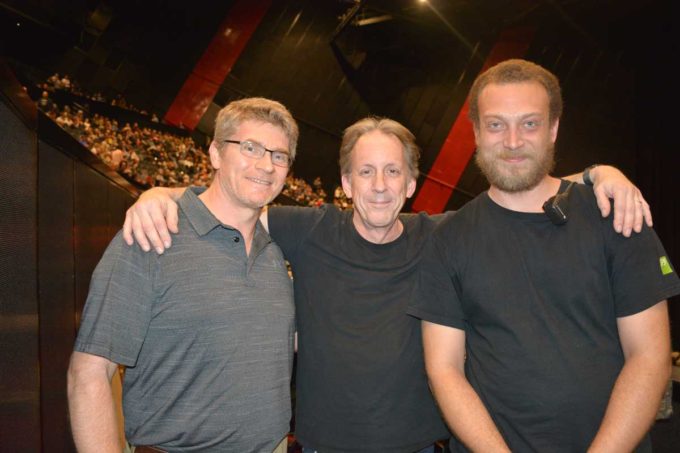David Byrne’s American Utopia
The most talked about and critically acclaimed concert this year has to be David Byrne’s American Utopia, which had the critics raving.
Not only was it a visual feast, it also sounded pretty damn good, thanks to FOH engineer Pete Keppler (who has mixed tours for music’s biggest icons, from David Bowie to ZZ Top) and JPJ Audio.
JPJ Audio’s Clair Cohesion system was out with the tour using an almost identical set up to the rest of the world tour.
“We’re using all CO-12s here in Australia”, commented Pete, “as opposed to the Co-12/Co-10 rig we were using in the USA. I had never brought Clair on a tour until I worked with Katy Perry starting in 2010, and she was a Clair account. Her production manager told me ‘you can use any sound company you want, as long as it’s Clair!’ And I’ve hardly used any other company since!
“When the Cohesion series became available, I was blown away at how well it performs, and how easy a system it is to set up and rig. I myself was one member of a group of engineers invited out to Clair a few years back for some lengthy questioning about line arrays, hardware, electronics and all kinds of stuff, and the information gathered was used to help design and create the Cohesion system.”
At Sydney’s ICC Theatre there were 16 x CO-12 per side on the front hangs and 12 x CO-12 per side on the side hangs. Because of the simplicity of the stage setup, Pete was not allowed to have any of the usual front-fill on the downstage edge, so a stack of (4) CO-8s was put on each of the two downstage corners, aimed in at the center 3-5 rows of audience.
“I use them as near-fill mostly to cover the very front rows in the center where the main PA doesn’t quite reach,” added Pete. “Also, I have 6 drummers on stage and no other instruments with any acoustic output, so the mix I send to the CO-8s is separate and has very little drums in it, and the CO-8s really cover that space and fill in the rest” And as for far-field coverage. “We’ve found with the CO-12 that the smaller angles (1 and 2 degrees) will exponentially increase the high-frequency throw. We did some outdoor shows where the Co-12s covered 400 feet with no trouble at all. Arrayed properly physically, this PA will save you a lot of work.”
In keeping with the clean stage design, the entire show is wireless and Pete says this show would not have been possible without the Shure Axient D, saying it’s hands-down the best RF system he has ever heard. “We did a shoot-out last year against a wired mic and an analogue RF system and I swear I could not tell the difference between this and the wired microphone,” he said.
Pete was running roughly 44 inputs of wireless from drums and vocals, another twenty or so inputs from keyboard interfaces, guitar amp modelers, etc. and the IEMs use 16 outs of Shure PSM1000. It’s an RF challenge for sure, but Clair’s Jamie Nelson ensured smooth sailing. “She’s our secret weapon,” says Pete, “Especially at festivals when the RF coordinator you were promised never shows up!”
FOH Pete uses a DiGiCo SD10 console, a surface he says he knows like the back of his hand. His one piece of outboard gear was a Lexicon PCM41 for use on just a few songs. “I’m a minimalist, and I like a small footprint.”
To cut down ambience and spill from all the live percussion into the vocal mics, Pete uses the Waves F6 Dynamic EQ plugin.
“I’m using the six bands of the F6 to really make the most of all the gain I have available on the vocals,” he explained. “I’m not a fan of permanent EQ on many sound sources, particularly vocals. I have the F6 plugin inserted via MultiRack on all the vocals, and I externally key one band of the F6 to act as a high-frequency downward expander, in addition to using several of the other bands as normal dynamic EQ.”
As the musicians rapidly change instruments throughout the show, the microphone systems have to be robust. The vocal mics are all DPA 4088s, DPA 4099 on most of the drums, Audix D6 on bass drums, Shure Beta 98s, Sennheiser e904s and Audio-Technica AE2300 for snares and high hats.
The setup at monitor world is a DiGiCo SD5, and SD rack, an SD Mini Rack, and two Soundcraft real-time rack units, in addition to all the RF transmitters and receivers. In Australia, Dan Matthews ran monitors as the tour’s original monitor engineer, John Chadwick, took a dive off the stage and injured himself.
Pete remarked that the other key piece of gear used was his ears and that he doesn’t look at sound if he can possibly avoid it! “Some folks spend their time focusing on what they’re seeing on metres and other visual indications, but I’m old school that way,” he laughed.
To the audience, this show appears to be very simple but no one sees what is behind the success of the show – a very significant amount of technology. Pete commented that JPJ have been great and that his techs, Alex McCormack and Tim Jones, did an amazing job.



Leave a Reply